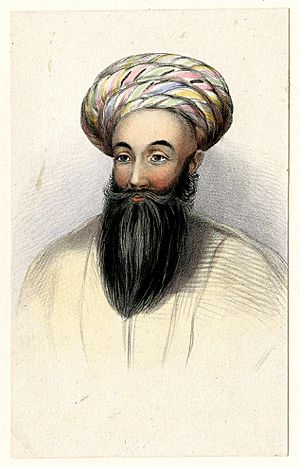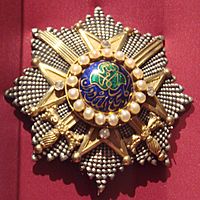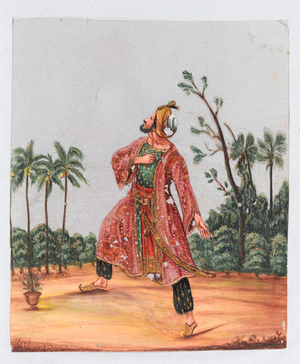Shah Shujah Durrani facts for kids
Quick facts for kids Shah Shuja Durraniشاه شجاع درانی |
|||||
|---|---|---|---|---|---|
| His Majesty Inayat-i-Ilahi Padshah Sultan Shah Shuja ul-Mulk Muhammad Bahadur,Abdali ,Dur-i-Durran, Padshah of Afghanistan | |||||

Lithograph by Lowes Cato Dickinson, after Vincent Eyre, showing Shah-Shuja-ul-Mulk
|
|||||
| Emir of the Durrani Empire | |||||
| Reign | 13 July 1803 – 3 May 1809 (First reign) 7 August 1839 – 5 April 1842 (Second reign) |
||||
| Coronation | 13 July 1803 | ||||
| Predecessor | Mahmud Shah Durrani | ||||
| Successor | Mahmud Shah Durrani Dost Mohammad Khan |
||||
| Born | 4 November 1785 | ||||
| Died | 5 April 1842 (aged 56) Kabul, Durrani Empire, now Afghanistan |
||||
| Wives |
|
||||
| Issue | Abdul Samad Khan Timur Mirza |
||||
|
|||||
| Dynasty | Durrani dynasty | ||||
| Father | Timur Shah Durrani | ||||
| Mother | a Sadozai lady | ||||
Padshah Sultan Shah Shuja Durrani (Pashto/Dari: شاه شجاع درانی ; November 1785 – 5 April 1842) was ruler of the Durrani Empire from 1803 to 1809. He then ruled from 1839 until his death in 1842. Son of Timur Shah Durrani, Shuja Shah was of the Sadduzai line of the Abdali group of ethnic Pashtuns. He became the fifth King of the Durrani Empire.
King of Afghanistan
Shuja Shah was the governor of Herat and Peshawar from 1798 to 1801. He proclaimed himself as King of Afghanistan in October 1801 (after the deposition of his brother Zaman Shah), but only properly ascended to the throne on July 13, 1803. In Afghanistan, a blind man by tradition cannot be Emir, and so Shah Shuja's step-brother Mahmud Shah had Zaman blinded, however not killed. After coming to power in 1803, Shuja ended the blood feud with the powerful Barakzai family and also forgave them. To create an alliance with them, he married their "sister" Wafa Begum.
In 1809, Shuja allied Afghanistan with British India, as a means of defending against an invasion of Afghanistan and the Punjab Region by France. In 1809, a British diplomatic mission was sent to Afghanistan, which at the time was to the British a remote and mysterious part of Asia. According to Mountstuart Elphinstone, "The King of Kabul [Shah Shuja] was a handsome man". He also wrote "of an olive complexion with a thick black beard ... his voice clear, his address princely." Shuja wore the Koh-i-Noor ("Mountain of Light") diamond in one of his bracelets when Elphinstone visited him, but rather undiplomatically described Shuja as having a "vulgar nose". William Fraser, who accompanied Elphinstone to meet Shah Shuja was "struck with the dignity of his appearance and the romantic Oriental awe." Fraser also judged him to be "about five feet six inches (168 cm) tall" and his skin colour was "very fair, but dead...his beard was thick jet black and shortened a little by the obliquely upwards, but turned again at the corners ... The eyelashes and the edges of his eyelids were blackened with antimony." He also described Shuja's voice as "loud and sonorous".

In June 1809, he was overthrown by his predecessor Mahmud Shah in the battle of Nimla, and went into exile in The Punjab, where he was captured by Jahandad Khan Bamizai and imprisoned at Attock (1811–1812) and then taken to Kashmir (1812–1813) by Atta Muhammad Khan. When Mahmud Shah's vizier Fateh Khan invaded Kashmir alongside Ranjit Singh's army, he chose to leave with the Sikh army. He stayed in Lahore from 1813 to 1814. During his time in India, Shuja was imprisoned and forced to give up the Timur Ruby, Koh-i-Noor and the sister diamond dray-i-nur diamond to Ranjit Singh . He escaped from Ranjit's detention at the Mubarek Haveli Lahore for Ludhiana and the East India Company.
From 1818 onward, Shuja who liked to live in a lavish style with his wives and concubines had collected a pension from the East India Company, which thought he might prove useful one day. Shuja stayed first in Ludhiana where he was joined by Zeman Shah in 1821. The place where he stayed in Ludhiana was occupied by the Main Post Office near Mata Rani Chowk and inside it there used to be a white marble stone commemorating his stay there.
Exile
Harlan, a man without much military experience and knowledge of Pashto, offered to lead an invasion of Afghanistan to restore Shuja, an offer that led the former monarch to break "into a poetical effusion in praise of Kabul" and its gardens, its trees laden with fruits, and its music, culminating with "Kabul is called the Crown of the Air. I pray for the possession of those pleasures which my native country alone can afford". When Harlan pressed him on whether he wanted to accept his offer or not, Shuja agreed. Harlan had a tailor sew up an American flag, which Harlan hoisted up in Ludhiana, and started to recruit mercenaries for the invasion of Afghanistan, suggesting that he was working for the U.S. government (which he was not). Harlan ultimately grew disillusioned with Shuja, writing that he did not view him as the "legitimate monarch, the victim of treasonable practices", but rather as "a wayward tyrant, inflexible in moods, vindictive in his enmities, faithless in his attachments, unnatural in his affections. He remembered his misfortunes only to avenge them".
In 1833, Shah Shuja struck a deal with Ranjit Singh of Punjab where he was allowed to march his troops through Punjab, and in return, he would cede Peshawar to the Sikhs if they could manage to take it. In a concerted campaign, the following year, Shuja marched on Kandahar, while the Sikhs commanded by General Hari Singh Nalwa, attacked Peshawar. In July, Shuja Shah was defeated at Kandahar by an alliance between the Qandahar Sardars and Dost Mohammad Khan. Shuja Shah fled. The Sikhs for their part reclaimed Peshawar.
Restoration of power
In 1838, Shah Shuja had gained the support of the British and the Ranjit Singh for wresting power from Dost Mohammad Khan. George Eden, 1st Earl of Auckland, believed that most Afghans would welcome the return of Shuja as their rightful ruler, but in fact, by 1838, most people in Afghanistan could not remember him, and those that did, remembered him as a cruel, tyrannical ruler and absolutely hated him. During the march on Kabul, the main British camp was attacked by a force of Ghazis, of whom 50 were captured. Shuja was restored to the throne by the British with the help of the Sikhs, on August 7, 1839, 30 years after his deposition, he did not remain in power when the British and Sikhs left. Upon being restored, Shuja announced that he considered his own people "dogs" who needed to be taught, how to be obedient to their master. He spent his time exacting bloody vengeance on those Afghans whom he felt had betrayed him, making him extremely unpopular with his people. He shut himself away in Bala Hissar, Kabul, but on April 5, 1842, when he left the place, he was assassinated by Shuja ud-Daula, at the insistence of his uncle Oosman Khan.


